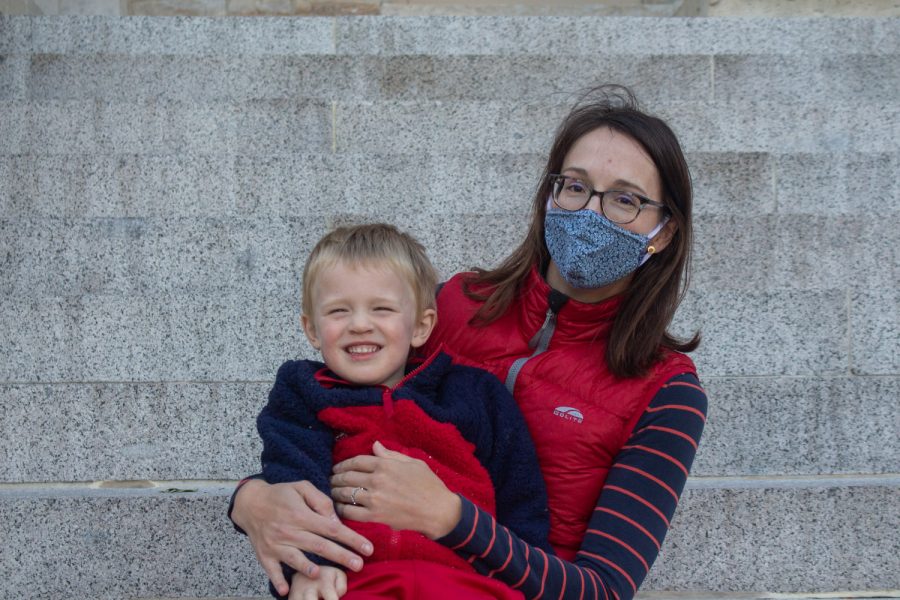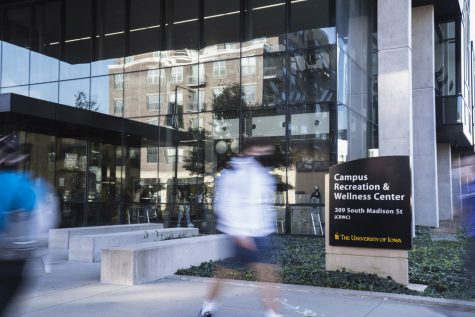Professors, TAs balance teaching and parenting in a pandemic
As the COVID-19 pandemic continues, UI faculty are balancing parenting and working from home.
University of Iowa Lecturer of Earth and Environmental Sciences, Mary Kosloski, and her son, Felix, pose for a portrait at the Pentacrest on Oct. 16.
October 18, 2020
Many teaching assistants and professors returned to campus this fall tasked with juggling teaching their classes and parenting and parenting at home during the pandemic.
University of Iowa Earth and Environmental Science Professor Mary Kosloski is currently trying to balance teaching college students and raising her three-year-old son.
Though only teaching online and asynchronous classes this fall, Kosloski said she still struggles to record lectures and have a child who cannot be left unsupervised.
“I’ve been trying to juggle getting the work for my classes done when I have a three-year-old at home,” she said. “I’ll get maybe two-to-three hours of work done during typical work hours, but most nights I’m working until midnight so I can rush an eight-hour workday in. It’s a lot of working later at night to accommodate my son.
Normally, Kosloski said her son would be in private daycare five days a week. After an uptick in the number of coronavirus cases in Johnson County when students returned to the UI, her family decided to take her son out of daycare for the foreseeable future.
Kosloski is not the only professor juggling their profession with parenting amid COVID-19. There are 1,204 faculty and staff members on campus with at least one dependent between the ages of five and 15, according to the UI’s School-Aged Child Needs Assessment survey.
Six-hundred-ninety faculty and staff members participated in the survey in August — a 57 percent response rate. Of those who responded, 34 percent had yet to decide if their child or children would attend any face-to-face instruction in the fall.
Just over 28 percent said they would not send their kids to in-person school, while more than 37 percent said they would if it was offered.
UI Lecturer in the Department of Theater Arts Megan Gogerty, a faculty member who opted to keep her two children at home because of COVID-19, said her family took a different approach to education — learning pods.
Learning pods are small groups of children who take on virtual learning together and at home. Gogerty said the pod is her elementary-aged daughter and one other student who is in her daughter’s class.
“Our family takes turns hosting the pod school and leading it,” she said. “Some weeks, the girls are at my house and my husband and I are in charge of monitoring them, which is an ordeal. They need a lot of hands on intervention just to stay on track. It’s hard for them and for us … the weeks they are with the other girl’s family, I work like hell to catch up on everything.”
RELATED: UI graduate students struggle to maintain safety and trust in their programs
A more hands-on approach to virtual learning has improved her daughter’s mental and developmental health, Gogerty said. Having her kids participating in remote learning has led to some interruptions during her Zoom classes, she said, but her students are understanding and gracious.
Professors are not the only ones adapting to teaching with kids. Ph.D. student in the College of Education Cheryl Ferguson is a teaching assistant this fall, and Ferguson’s two children are in their 20s and navigating the job market amid the pandemic.
She said the ability to teach from anywhere benefits her when it comes to helping her 22 and 24-years-old children move, as well as staying on top of her own education.
“My husband and I drove to help our daughter move and I attended two classes online that day while we were driving,” she said. “If we would’ve been in-person, I wouldn’t have been able to do that at all.”
UI Lecturer in the Sports Studies Program Jennifer Sterling has two children like Gogerty, but her family opted for in-home childcare during the pandemic. She said the decision was a result of reevaluation of her family’s options following spring semester.
“My approach to designing my classes for this [academic] year with children in the home and knowing how spring went is I planned office hours and how many times I’m meeting synchronously with students to help avoid Zoom fatigue for my students,” she said. “I try to create flexibility for me at home to help me balance kids and work.”
One of the most difficult parts of her job to be transferred online was her research, Sterling said. Time constraints regularly impact her ability to teach, parent, and write the book she’s currently working on, she said.
“Right now, I’m finishing up a book chapter that I’m co-authoring, and having a co-author definitely helps so I don’t have to shoulder the whole burden of research,” she said.
Associate Professor of Journalism and Mass Communications Brian Ekdale said he and his wife, who is also a professor, had to adapt their schedules to ensure someone can always be the point person for their seven-year-old daughter’s education.
“It’s a lot of shuffling around,” he said. “Doing all of the childcare responsibilities and managing this type of home schooling, it takes time. And that time has to come from somewhere. It either comes from professional or personal time or sleep.”
Having two classes with in-person aspects makes it more difficult for Ekdale’s family to adapt to his hybrid teaching and his daughter’s hybrid classes, forcing the responsibility onto his wife — something Ekdale said he hopes the university takes into account.
“I’m very cognizant that a lot of these family commitments fall upon women,” he said. “It’s both something that the university needs to be aware of structurally to see how these demands can affect women’s professional status and their ability to achieve, but it’s also important for men to be cognizant of it in their own lives. Men cannot leave the burden just on their partners.”






















